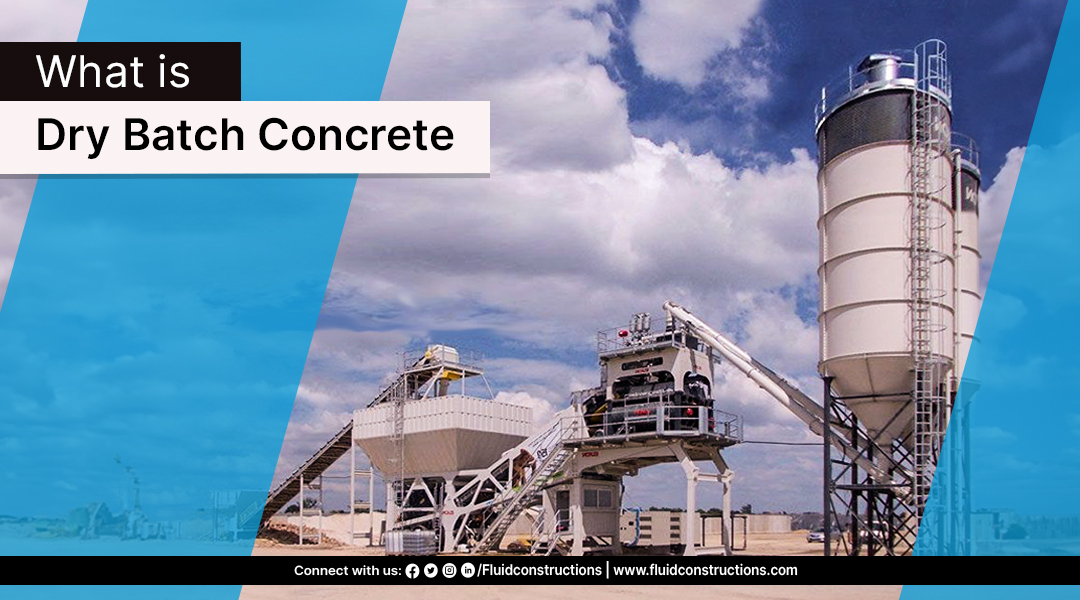
What is Dry Batch Concrete
Modern construction aims to achieve better performance in an eco-friendly way and at a lower cost. The use of dry-batch concrete helps meet all criteria by offering some unique advantages.
However, dry-batch concrete is best used for some specific applications. Therefore, the contractors use both dry-batch concrete and its elder cousin, wet-batch concrete, where they are most suitable, to achieve a high overall performance for their project.
What is Dry Batch Concrete?
Dry-batch concrete, dry-mix concrete, or dry-pack concrete is basically a concrete mix without water. The mix comprises cement, aggregates, and sand blended in the correct ratios in a plant and then transported to the construction site on a truck. The final mixing and agitation with water takes place in the mixer truck during transportation.
This is unlike wet-mix concrete, which is mixed in the batching plant and transported to the construction site in a ready-made mix.
Dry-mix cement contains the same elements as a standard concrete mix but contains less water. Therefore, dry concrete is mostly used for applications where it will come into contact with the ground and draw the water required to bind the mortar (hydration process). Building foundations, base layers for roads, driveways, paving stones, trench filling, and other similar applications are ideal for dry-mix concrete.
Wet mix, on the other hand, works effectively in high-volume areas that are developed from the ground up, such as when building a house or other new construction.
Advantages of Dry Batch Concrete
As said before, dry-mix concrete has some unique advantages, such as:
Improved strength and durability
Despite having a reduced cement percentage, dry-mix concrete has excellent strength and durability. The combination of aggregates and a small amount of cement ensures structural stability and appropriate binding. Dry mix concrete is capable of withstanding enormous weights, resisting deformation, and withstanding harsh weather conditions, ensuring long-lasting and durable buildings.
Cost-effectiveness
When compared to typical concrete mixtures, dry-mix concrete is a more cost-effective choice. Furthermore, the effective mixing and placing process of dry mix concrete requires fewer labourers, which contributes to cost savings.
Long storage time
When it comes to storage time, dry-mix concrete provides more flexibility. Contractors can fill dozens of bags of dry mix concrete and use them only as needed. During application, a high-velocity hose is used to lay the dry mix before immediately adding water.
Simple to use
Because dry-mix concrete is pre-mixed and bagged, it is simple to transport and store on-site. Hence, there is no requirement of on-site machinery, which saves time and money.
Rapid construction
Dry-mix concrete enables quick and efficient construction. Because it is a dry combination, it can be simply spread and compacted with specialised equipment. The lack of water in the mixture reduces the requirement for curing, allowing for fast construction progress. This results in saving both time and money.
Eco-friendliness
Dry-mix concrete is an environmentally friendly alternative due to its low cement composition. Because cement manufacturing has a high carbon footprint, employing DLC helps reduce the environmental impact. Furthermore, by properly utilising aggregates, DLC minimises the demand for natural resources, making it a sustainable solution for construction projects.
High quality and consistency
Dry-mix concrete is manufactured under regulated conditions, ensuring constant quality and strength. It also removes the possibility of differences in mix proportions affecting the final product’s strength and durability.
Minimised waste
The pre-mixed nature of concrete eliminates the need for excess material, reducing waste and saving money. It also reduces the environmental impact of construction-related on-site mixing and rubbish creation.
Disadvantages of Dry Batch Concrete
Following are the few disadvantages of dry-mix concrete.
Inconvenient for complex structures
Due to the short workable period of dry-mixed concrete, it is inappropriate for large-scale projects or complex structures. It hardens quickly and cannot be reused once set.
Requires the availability of sufficient water at the site.
Dry-mix concrete requires on-site water, which can be difficult in places with low water availability. This may lead to delays in completing the project and increase the cost.
Applications are limited.
Dry-mix concrete is not appropriate for all types of construction. It is primarily used for structural purposes and should not be used for aesthetic or surface finishes.
Dust and Respiratory Risks
Dry-mix concrete can generate a substantial amount of dust during mixing and application, posing a respiratory hazard to on-site employees. To ensure worker safety, proper safety measures must be implemented.
How is Dry Batch Concrete Produced?
A traditional concrete mixing plant uses a concrete mixer to mix all of the elements, such as sand, cement, aggregates, and water, after they have been weighed to maintain precise ratios. But there is no concrete mixer in a dry-mix concrete batching plant to mix all of the components. It operates in the following manner:
1) Aggregates (sand and stone) are weighed by an aggregate batching machine and then supplied by a belt conveyor to an aggregate collecting hopper.
2) Water, cement, and additive scales are located on top of the aggregate collecting hopper. Water, cement, and additives are weighed by the corresponding scale and then discharged into the aggregate collecting hopper.
3) A concrete transit mixer truck collects all the materials from the hopper. The concrete transit mixer mixes all ingredients on the way to the work site. When the transit mixer arrives at the job site, the concrete is ready to use.
What is the Mixing Ratio of Dry Batch Concrete?
The mixing ratio of dry-mix concrete might vary depending on the project’s specific requirements. However, a popular dry mixing ratio is 1:6:12.
Consider the following hypothetical amount of dry-mix concrete components to demonstrate this mixing ratio:
If the cement used is 50 kg, the amount of fine aggregate, i.e., sand, will be 300 kg, and the amount of coarse aggregate will be 600 kg.
